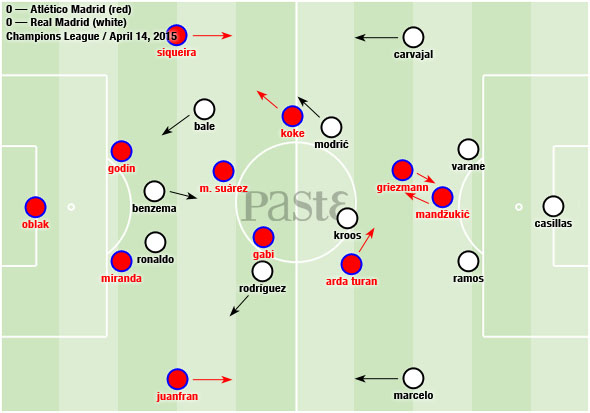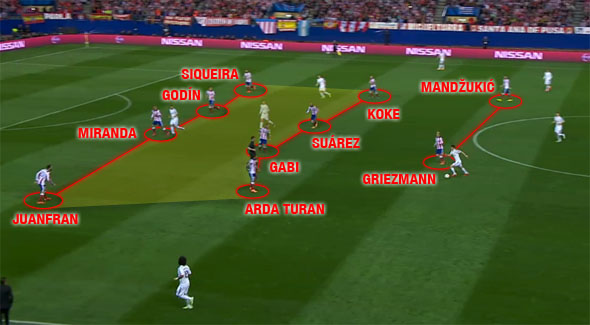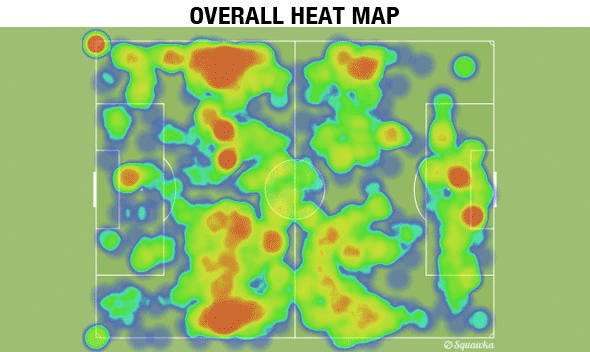Tactical Analysis: Atlético Madrid vs. Real Madrid in the Champions League
Soccer Features Champions LeagueAnother fiery Madrid Champions League derby finished goalless on Tuesday despite Real Madrid’s best efforts at the Vicente Calderón. The visitors out-chanced and outshot Atlético Madrid, 9-5 and 17-8, but goalkeeper Jan Oblak made a series of saves to keep Atléti from losing the first leg.
His interventions started early, with a one-on-one save on Gareth Bale in the fourth minute, and continued with stops on long-distance shots from Bale and James Rodríguez. Oblak’s sharp handling and fast footwork got him across the goal and down to safely smother every opportunity.
Real created multiple goalscoring chances despite Atlético’s low defensive block, while Atléti resorted to cross after cross in an attempt to get one past Iker Casillas.

Neither team varied tactically from its normal set-up, with Atlético manager Diego Simeone choosing a 4-4-2 system meant to stifle Real’s build-up in possession and Carlo Ancelotti going with his hybrid 4-4-2/4-3-3.
The Atlético midfield began narrow, flattening as play neared its own goal and Real moved the ball into wider areas. For the away side, Bale, Karim Benzema and Cristiano Ronaldo played narrow in attack and tried to find space between lines, which was scarce.

Atléti emphasized clogging passing lanes and limiting service to the “BBC” trio at the head of Real’s attack. Forwards Antoine Griezmann and Mario Mandžuki? often retreated into their own half as well to pressure passes from Real pivote Toni Kroos.
Because of the opposition’s low block, Real often committed up to nine outfield players to its attack, leaving just one center back to deal with counterattacks. Atlético conceded possession and played vertically through the channels when it won the ball.
Just two of Atlético’s five goalscoring chances came off the foot of central players, and no individual created more than one opportunity. Rodríguez created four for Real, and its midfielders found ways to remain effective even without having free run in central areas.

Rodríguez and Luka Modri? pushed wider, playing more in the half-spaces between the wide and middle zones, and pulled the strings for Real’s attack from those areas. With the fullbacks overlapping freely, that left the three forwards to run the middle.
Real’s most common pattern in build-up began with Kroos on the ball. He distributed wide to either a central-midfield partner or one of the fullbacks, and they played the next pass as appropriate.
At times, they could penetrate centrally, but they often had no choice but to cross, attempting 29 to Atlético’s 28 throughout the match. Despite having full control over much of the game, Real couldn’t create an opportunity clear-cut enough to score. Oblak kept the Galácticos out on the occasions they made it through the stingy defensive block in front of him.

All three of Real’s central midfielders finished with favorable passing statistics. Kroos completed a whopping 97 percent of his attempts and missed on just two efforts, while Modri? succeeded 94 percent of the time and Rodríguez created multiple chances despite a relatively low 86-percent success rate overall.
Modri? and Rodríguez tried to play around the stifling defensive block facing them rather than stubbornly forcing passes through the middle. Nonetheless, that moved them into less vital areas on the ball and prevented them from being too dangerous in what they created.
The match progressed largely as Atlético would have wanted, with Real unable to score an away goal and the flow of the game stilted by numerous fouls. The match progression remained choppy throughout, as tempers flared and players clashed multiple times.
Atlético has owned this match-up domestically in recent seasons, but the Champions League has been a different story. Real won the final last year in extra time, and despite not scoring a goal on Tuesday, it has the advantage heading into the home leg this year.
Simeone’s team hasn’t lost, winning four and drawing two, against its fiercest rival since being beaten for la décima. All but one of those wins have come at home, but Real has not kept a clean sheet against Atlético at the Santiago Bernabéu in the last three tries.
Another draw, as long as it includes an Atlético goal, would give Los Colchoneros a win on away goals. The return leg should be another intriguing match, and as always in the Champions League, anything can happen over 90 minutes.